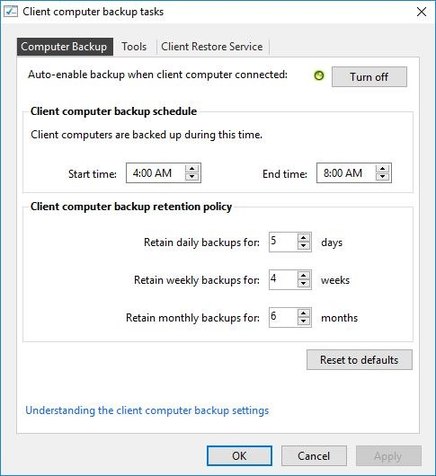-
 Jon T
2I own CloudBerry Pro licenses on my Windows PC clients. I live in hurricane country and I run backups to BackBlaze B2 as my cloud backup in case something really nasty wipes out both my home and the local bank vault containing my off-site rotated backup-of-my-backup copies.
Jon T
2I own CloudBerry Pro licenses on my Windows PC clients. I live in hurricane country and I run backups to BackBlaze B2 as my cloud backup in case something really nasty wipes out both my home and the local bank vault containing my off-site rotated backup-of-my-backup copies.
I'm considering using Windows 10 Pro as a home server OS instead of Windows Server Essentials (WSE). WSE has a nice centralized client backup mechanism that is easy to configure and has easy-to-understand retention semantics (see attached).
Retain daily backups for x days -- default is 5 days
Retain weekly backups for y days -- default is 4 weeks
Retain monthly backups for z days -- default is 6 months
This setup is a good compromise to the number of backups stored (i.e. 6 months of dailies is overkill) and I've always been able to find a file I need especially when run in tandem with File History for really short-term stuff. If I need a file I deleted more than a week ago, It's always been on one of the weeklies or monthlies. I can restore a full system or restore just files or folders. Network boot restore offered by WSE has been very nice to have but not essential (a USB key is fine).
I must admit I find the retention settings in CloudBerry a bit bewildering. How could I construct backup job(s) with the same retention semantics?
Maybe?
- A daily block job that deletes versions older than 5 days (but would that delete older weeklies and monthlies?)
- A weekly block job that deletes versions older than 4 weeks (but would that delete older monthlies?)
- A monthly block job that deletes versions older than 6 months
Question: does each backup job manage the retention of only the backups it creates? For example would my daily job blow away all the weekly and monthly backups because they're older than 5 days?
Also: How would I fit in run the recommended full backups in such a plan?
Thanks for any advice and guidance!
Jon T.Attachment WSE2016 Client Backup
(49K)
WSE2016 Client Backup
(49K)

-
 David Gugick
118You can’t really construct the equivalent retention in CB, currently. We are hard at work to offer that exact retention feature (we refer to it as GFS - Grandfather - Father - Son) and when it’s released later this year, it will do what you need. In the meantime, the retention is version based. If you set the number of versions of each file you want to keep and do set a long term retention period, you can manage storage. Can I assume you’re performing file backup? Or are you using image backups?
David Gugick
118You can’t really construct the equivalent retention in CB, currently. We are hard at work to offer that exact retention feature (we refer to it as GFS - Grandfather - Father - Son) and when it’s released later this year, it will do what you need. In the meantime, the retention is version based. If you set the number of versions of each file you want to keep and do set a long term retention period, you can manage storage. Can I assume you’re performing file backup? Or are you using image backups? -
 Jon T
2Thanks for the quick reply, especially on a weekend :grin:
Jon T
2Thanks for the quick reply, especially on a weekend :grin:
Not sure which you're asking about, so here's both:
WSE does image backups, but the restore wizard allows you to restore an entire system, just a volume, or pick files and/or folders.
Right now, my current CloudBerry jobs to BackBlaze B2 are daily file backups of the key user file directories (Documents, Pictures, Music, Videos, etc.) which keeps the last 3 file versions and purges deletions after 30 days. Because BackBlaze is my 5th level backup (1. loss of file, 2. loss of disk, 3. loss of PC, 4. loss of house, 5. loss of bank vault (loss of city), The files are more important than OS images because the PCs and my WSE server are presumably totally destroyed in catastrophes 4 and 5. It keeps the cloud backups smaller because I'm not backing up the OS, but gosh, BackBlaze is so inexpensive. The total I store today in BackBlaze to backup 2 PC's and my WSE server shares is about 500GB costing me about $2.50 a month in storage. -
 Anton Zorin
30, let me describe a workaround while we don't have GFS in place:
Anton Zorin
30, let me describe a workaround while we don't have GFS in place:
It would require 3 buckets and 3 plans, each having it's own retention and destination.
But except for daily backups, I personally think that block level is not a good option that could makes your desired retention policy much longer.
Thanks
Welcome to MSP360 Forum!
Thank you for visiting! Please take a moment to register so that you can participate in discussions!
Categories
- MSP360 Managed Products
- Managed Backup - General
- Managed Backup Windows
- Managed Backup Mac
- Managed Backup Linux
- Managed Backup SQL Server
- Managed Backup Exchange
- Managed Backup Microsoft 365
- Managed Backup G Workspace
- RMM
- Connect (Managed)
- Deep Instinct
- CloudBerry Backup
- Backup Windows
- Backup Mac
- Backup for Linux
- Backup SQL Server
- Backup Exchange
- Connect Free/Pro (Remote Desktop)
- CloudBerry Explorer
- CloudBerry Drive
More Discussions
- Terms of Service
- Useful Hints and Tips
- Sign In
- © 2024 MSP360 Forum




